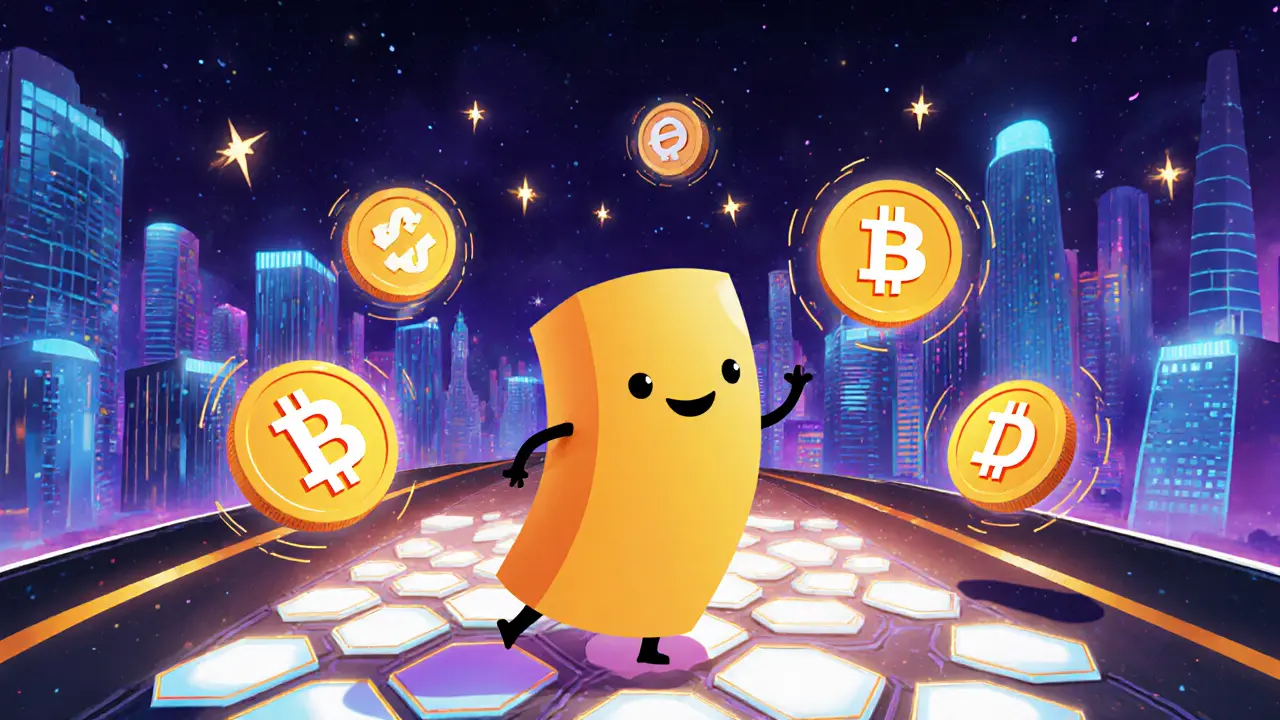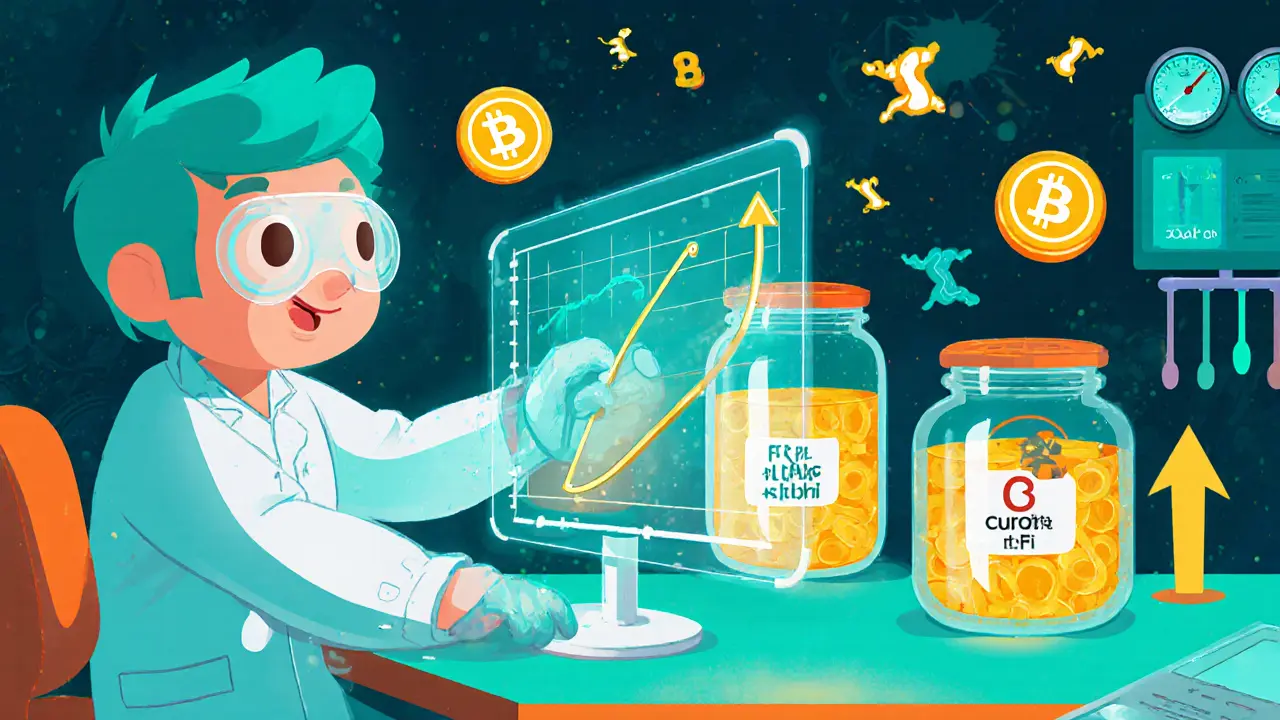 Oct, 14 2025
Oct, 14 2025
Stablecoin Swap Calculator for Curve on Polygon
Calculate estimated slippage, fees, and potential rewards when swapping stablecoins on Curve's Polygon network. Based on current protocol parameters (2025).
Slippage is estimated based on current liquidity pools. For $100k trades, slippage typically stays under 0.01%.
Liquidity Provider Rewards
Curve's liquidity pools typically offer 12-18% APR (including gauge rewards). Your share depends on pool weight and staked CRV.
When you hear the name Curve in the DeFi world, you’re hearing about a specialized DEX that makes stablecoin swaps feel like a breeze. Curve Finance is a decentralized exchange built around an automated market maker (AMM) algorithm that’s tuned for assets with near‑identical values. Its core mission is to offer ultra‑low slippage, cheap fees, and deep liquidity for stablecoins and other pegged tokens. In 2025 the protocol runs on several chains, but the Polygon network provides a high‑throughput, low‑cost environment that amplifies Curve’s advantages. This review walks through how Curve works on Polygon, what you get as a trader or liquidity provider, and where the platform stands compared with other DEXs.
Why Curve Chooses Polygon
Polygon’s gas fees average under $0.01 per transaction, a fraction of Ethereum’s $5‑$10 typical cost in 2025. That price difference matters when you’re swapping $1,000‑$10,000 stablecoin positions daily. The network’s block time of ~2 seconds also means near‑instant confirmations, eliminating the waiting period that can expose traders to price drift on slower chains. Curve leverages these benefits without sacrificing the deep liquidity it built on Ethereum, thanks to cross‑chain bridges like LayerZero and Wormhole that funnel liquidity from the mainnet to Polygon pools.
Core Mechanics: The Stablecoin‑Focused AMM
Most AMMs, like Uniswap, pair assets of wildly different prices-ETH vsBTC, for example. Curve’s algorithm, however, assumes the assets share the same peg. This assumption lets the protocol use a tighter bonding curve, which cuts price impact dramatically. For example, swapping USDC for USDT in the 3‑pool (USDC, USDT, DAI) on Polygon typically incurs less than 0.01% slippage, even for a $100k trade. The math behind the curve automatically adjusts based on volatility, and the 2024 “adaptive curve” upgrade fine‑tunes pool parameters in real time.
Key Pools on Polygon
- 3‑pool (USDC, USDT, DAI) - the go‑to pool for major US‑dollar stablecoins.
- FRAX‑USDC pool - enables inexpensive swaps between a partially algorithmic stablecoin and a fiat‑backed coin.
- stETH‑wstETH pool - for users who want to move between staked ETH and its wrapped version without leaving Polygon.
- crvUSD pool - integrates Curve’s native over‑collateralized stablecoin, now exceeding $120million in circulation.
Each pool draws liquidity from both Polygon‑native deposits and bridged assets, so traders benefit from the same depth they’d see on Ethereum while paying a fraction of the gas.

Fees, Rewards, and Yield Opportunities
Trading fees on Curve are among the lowest in DeFi-typically 0.04% on stablecoin pools, with a portion sent to liquidity providers (LPs) and the rest to the protocol’s treasury. On Polygon, the fee is paid in the native token CRV (the governance token that also serves as a reward mechanism for LPs). LPs can lock CRV to obtain veCRV, which boosts their share of future fees and grants voting power.
Beyond fee income, Polygon LPs can also earn additional incentives through “gauge” rewards-extra CRV or custom tokens distributed by Curve’s DAO. The 2025 UI overhaul shows each gauge’s APR, making it easy to compare opportunities across pools.
Comparing Curve on Polygon vs. Other DEXs
| Feature | Curve on Polygon | Uniswap V3 (Polygon) | SushiSwap (Polygon) |
|---|---|---|---|
| Primary focus | Stablecoin & pegged‑asset swaps | General‑purpose swaps | General‑purpose swaps |
| Typical slippage (100k trade) | ~0.01% | ~0.25% | ~0.30% |
| Average fee | 0.04% | 0.30% | 0.25% |
| Liquidity depth (USDC) | $1.8B (Polygon‑bridged) | $850M | $770M |
| Yield for LPs (APR) | 12‑18% (incl. gauge rewards) | 4‑6% | 5‑7% |
The table shows why Curve dominates stablecoin trading on Polygon: lower slippage, cheaper fees, and richer yields. If you’re looking to swap unrelated assets, Uniswap and SushiSwap still have broader pair coverage, but for stablecoins the math clearly favors Curve.
Getting Started: A Step‑by‑Step Walkthrough
- Install a Web3 wallet (MetaMask is the most common).
- Add the Polygon network to MetaMask: RPC URL https://polygon-rpc.com, Chain ID 137, Symbol MATIC.
- Fund the wallet with a small amount of MATIC for gas.
- Navigate to Curve’s Polygon interface (the URL is not a link per policy, but you can copy it).
- Connect your wallet via the “Connect Wallet” button.
- Select the pool you want to trade-e.g., 3‑pool for USDC↔USDT.
- Enter the amount, review the estimated slippage, and confirm the transaction.
- If you want to provide liquidity, click “Add Liquidity,” deposit the required stablecoins, and receive LP tokens.
- Lock CRV for veCRV if you wish to boost future rewards and participate in governance.
The whole process takes under five minutes for a first‑time user once the wallet is set up.

Risk Considerations
Even though Curve’s design minimizes impermanent loss, you still face typical DeFi risks: smart‑contract bugs, bridge exploits, and regulatory changes. The 2025 audit by Quantstamp gave Curve’s core contracts a “high confidence” rating, but the cross‑chain bridges (LayerZero, Wormhole) have had isolated incidents in the past, so diversifying across bridges can help. Also, veCRV lock periods range from 1 to 4 years; consider your liquidity horizon before committing.
Future Outlook for Curve on Polygon
The roadmap points to deeper integration with Polygon’s emerging lending platforms, enabling seamless yield‑farming loops: deposit stablecoins into Curve, earn CRV, then feed the LP tokens into Aave v3 on Polygon for extra interest. Additionally, the “adaptive curve” upgrade continues to learn from on‑chain data, promising even tighter spreads as volume grows. With Polygon’s developer ecosystem expanding-new NFT marketplaces, gaming protocols, and layer‑2 rollups-Curve is well positioned to remain the go‑to DEX for stable assets across the network.
Frequently Asked Questions
Does Curve on Polygon charge a gas fee?
Yes, you pay a tiny amount of MATIC for each transaction. In 2025 the average cost is under $0.01, making even small swaps economical.
Which stablecoins can I trade on Curve’s Polygon pools?
The main options are USDC, USDT, DAI, FRAX, and the native crvUSD. Additional pools exist for wBTC‑renBTC and stETH‑wstETH.
How do I earn CRV rewards as a liquidity provider?
When you add liquidity, you receive LP tokens. Those tokens automatically accrue a share of the 0.04% trading fee, plus any gauge incentives the DAO adds. You can also lock CRV for veCRV to boost your share.
Is Curve on Polygon safe for large trades?
Yes. The 3‑pool holds over $1.8billion in stablecoins on Polygon, meaning you can swap six‑figures with under 0.01% slippage. However, always double‑check the bridge status before moving large sums.
What’s the biggest downside of using Curve on Polygon?
Its specialization. If you want to trade non‑stable assets like ETH/BTC pairs, you’ll need another DEX. Curve’s UI is also geared toward DeFi veterans, so beginners may face a learning curve.
Bobby Lind
October 14, 2025 AT 04:40Wow, the gas fees on Polygon are practically nothing, and Curve makes stable swaps feel like a breeze, right??? This setup is perfect for anyone who wants to keep costs low, especially when moving thousands of dollars around, and the speed is insane!!!
DeAnna Brown
October 18, 2025 AT 19:47Honestly, if you’re not using Curve on Polygon you’re basically throwing away your dollar. The US market deserves the lowest slippage, and this platform delivers it like a champ. No more excuses, just jump in and start saving.
Chris Morano
October 23, 2025 AT 10:54Speed and cheap fees are key for high‑frequency traders. Polygon’s sub‑cent gas makes it viable for daily stablecoin rebalancing.
Ikenna Okonkwo
October 28, 2025 AT 01:00From a broader perspective, the reduced friction reshapes how liquidity providers allocate capital across chains. When transaction costs vanish, the opportunity cost of idle capital drops dramatically, encouraging deeper pool participation. Moreover, the seamless bridge integration fosters a more interoperable ecosystem. This alignment of incentives can drive sustainable growth for both Curve and the Polygon network. In the long run, we might see a shift in DeFi's liquidity geography.
Deborah de Beurs
November 1, 2025 AT 16:07Alright, let me be blunt: Curve on Polygon is a game‑changer, and anyone still stuck on high‑fee DEXes is living in the past. The interface may look sleek, but it’s the under‑the‑hood efficiency that truly shines. Dive in, stake some CRV, and watch those rewards stack up like fireworks on the Fourth of July.
Sara Stewart
November 6, 2025 AT 07:14Exactly, the fee structure is practically negligible, and the APRs on the 3‑pool are among the best in the space. Leveraging gauge incentives can boost yields further, especially when combined with veCRV locking. It’s a solid strategy for maximizing fee income while maintaining exposure to stablecoins.
Laura Hoch
November 10, 2025 AT 22:20One can't overlook the philosophical elegance of a stablecoin‑focused AMM; it whispers of efficiency and purpose. By tightening the bonding curve, Curve reduces slippage to almost nothing, which is a subtle yet profound shift in market dynamics. This design not only benefits traders but also aligns incentives for liquidity providers seeking steady returns. It’s a quiet revolution that many might miss at first glance.
Devi Jaga
November 15, 2025 AT 13:27Sure, but let’s not pretend it’s flawless-bridges can still hiccup, and the UI isn’t exactly beginner‑friendly. If you’re new, you’ll probably feel a bit lost before you even make your first swap.
Hailey M.
November 20, 2025 AT 04:34Whoa, the APR numbers are insane 😲💰-I mean, who wouldn’t want to lock CRV and see those extra tokens rain down? Still, you’ve got to watch the lock periods; they’re not exactly a weekend hobby.
Schuyler Whetstone
November 24, 2025 AT 19:40Look, I’ve been around the block more times than I care to admit, and I can tell you straight up that the promise of “insane” APRs often hides a slew of hidden comp‑fees and vesting cliffs that will chew through your gains faster than a rabbit on caffeine. First, the gauge rewards are distributed in CRV, which itself is subject to price volatility, so your nominal yield could evaporate if the token tanks. Second, locking veCRV for years ties up capital that could otherwise be deployed elsewhere, and the opportunity cost becomes glaring when market conditions shift. Third, the cross‑chain bridges, while convenient, have a track record of occasional exploits that can leave you scrambling for a rescue plan. Fourth, user interfaces still assume a level of DeFi literacy that the average joe simply doesn’t have, meaning you might make a mistake and lose funds. Fifth, the “adaptive curve” upgrade sounds shiny, but it also means the parameters are constantly tweaked, which could affect expected slippage in ways you didn’t anticipate. Sixth, the gas fee savings on Polygon are real, but you still need a stash of MATIC to cover those tiny transactions, and if MATIC spikes, those “sub‑cent” fees can balloon unexpectedly. Seventh, the veCRV boost is meaningful only if you hold a substantial amount of CRV, which many casual users don’t. Eighth, the governance model is still evolving, and future proposals could re‑allocate rewards in ways that disadvantage current LPs. Ninth, the liquidity depth is impressive now, but it’s susceptible to large outflows if market panic hits, potentially causing temporary slippage spikes. Tenth, the documentation, while thorough, is scattered across multiple sites, making comprehensive understanding a chore. Eleventh, the security audits are reassuring, yet no system is immune to novel attack vectors that haven’t been imagined yet. Twelfth, the integration with other Polygon protocols is promising, but each new partnership adds another layer of inter‑dependency risk. Thirteenth, the tokenomics of crvUSD, while innovative, introduce over‑collateralization requirements that can be complex to manage. Fourteenth, the community support is active, but the sheer volume of information can be overwhelming for newcomers. Finally, if you’re willing to navigate all these nuances with diligence, the rewards can indeed be worthwhile, but don’t go in blind; do your homework, stay updated, and manage risk responsibly.
David Moss
November 29, 2025 AT 10:47Now, if you think all these platforms are just benign tools, think again-there’s a hidden agenda to centralize power through veCRV governance that most users aren’t even aware of! The layers of contracts, the obscure bridges, the token incentives-they’re all designed to funnel control to a select few.
Vinoth Raja
December 4, 2025 AT 01:54While conspiracy theories can be entertaining, the actual data shows that governance participation is fairly distributed across token holders, and the protocol’s open‑source nature allows anyone to audit the code. It’s more productive to focus on transparent metrics and community proposals.
Kaitlyn Zimmerman
December 8, 2025 AT 17:00If you’re looking for a quick start guide, begin by adding MATIC to your wallet, then bridge a modest amount of USDC to Polygon, and finally hop onto the 3‑pool to test a small swap. Watching the slippage preview will give you confidence before you scale up. Also, remember to lock a portion of CRV for veCRV if you plan to stay long term; it amplifies your fee share without adding extra risk.
Jessica Cadis
December 13, 2025 AT 08:07That’s solid advice, but don’t forget to check the bridge status page before moving large sums-any downtime can lock your assets for hours. Keeping an eye on the gauge APRs daily also helps you optimize where your liquidity goes.